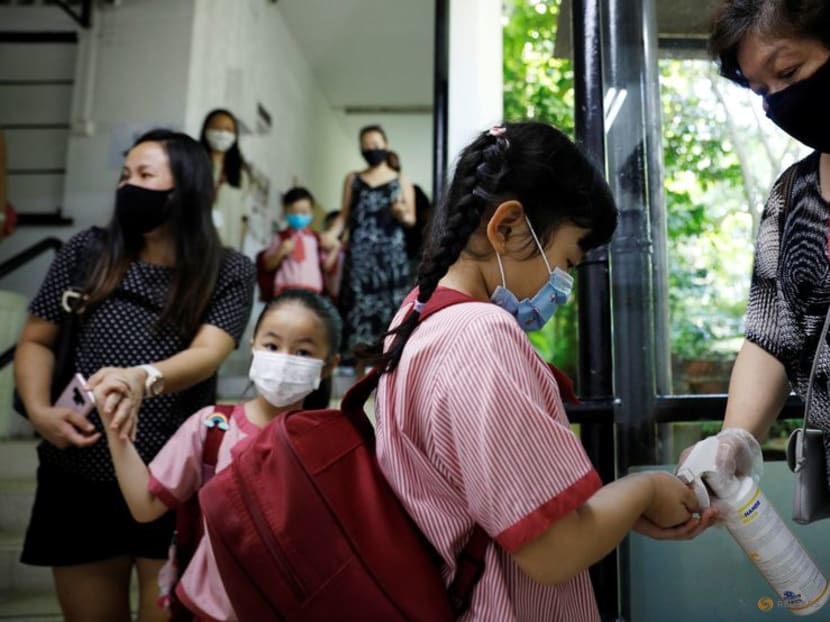MIS-C linked to COVID-19 infection in children: How worried should parents be?

Children wearing protective face masks sanitise their hands as they attend preschool classes at St James' Church Kindergarten as schools reopen amid the COVID-19 outbreak in Singapore on Jun 2, 2020. (File photo: Reuters/Edgar Su)
SINGAPORE: There were five cases of multi-system inflammatory syndrome in children (MIS-C) linked to COVID-19 infection reported in Singapore as of Monday (Nov 8).
The cases, among more than 8,000 paediatric COVID-19 cases in Singapore since the start of the pandemic, are "considered rare", the Ministry of Health (MOH) said. The age range of four of the cases is two months to eight years.
During a press conference on Monday, Senior Minister of State for Health Janil Puthucheary said there is a fifth case, although he did not provide additional details.
But, reiterating that the disease is rare, Dr Puthucheary explained what the disease does.
He said: “This condition, it affects different body organs including the heart, the lungs, the kidneys, the brain, the eyes, they can be inflamed,” he said.
MOH said that MIS-C is similar in presentation to Kawasaki Disease which has been linked to various virus or bacterial infections, and occurs in 150 to 200 children a year in Singapore.
Symptoms of MIS-C include persistent fever above 38.5 degrees Celsius for three days or more, with difficulty breathing, headache, neck swelling, rash, swollen hands and feet, conjunctivitis, diarrhoea or abdominal pain.
CNA spoke to paediatricians to find out more about the disease and how worried parents should be.
Who is more likely to get MIS-C and when?
MIS-C is a hyper-inflammatory syndrome which occurs in a child two to eight weeks after COVID-19 infection, causing fever, inflammation, and multi-organ involvement, said Dr Chan Si Min from the Khoo Teck Puat – National University Children’s Medical Institute at the National University Hospital.
It is likely that Singapore will continue to see cases of MIS-C as COVID-19 transmission and infection in the community continues, said Dr Chan, head and senior consultant from the Division of Paediatric Infectious Diseases at the institute. As young children are currently unvaccinated, they continue to be vulnerable, she added.
The main risk factors for MIS-C are age and a likely history of COVID-19 infection in the last two to 10 weeks, said Dr Alison Joanne Lee, a paediatrician with SBCC.
While children aged between seven and 10 years old are at highest risk, the age range for MIS-C varies from three months to 20 years old, added Dr Lee, who has a special interest in immunology and allergy.
“As this is a COVID-19 associated disease, a significant contact history or being infected with COVID-19 is the main risk,” she said.
Some doctors also pointed to obesity.
“There has not been a definite risk factor identified thus far, but male gender and obesity may increase the risk,” said Associate Professor Thaschawee Arkachaisri from KK Women’s and Children’s Hospital.
Dr Lim Yang Chern, consultant paediatrician at Thomson Paediatric Centre said while there is no reliable way to predict which child will develop MIS-C, “all children in Singapore have early access to good care and top-notch interventions comparable to the best centres around the world”.
How worried should parents be?
Dr Chan said that given that the disease is not common, parents should not be “unduly worried”.
However, they should be aware of the features of MIS-C and seek medical attention early, he said.
Similarly, Assoc Prof Arkachaisri said that despite much about the disease not being known yet, parents should not be "overly concerned” because this syndrome is treatable if it is detected early.
“Most patients can make full recovery and lead normal lives, such as the cases that our care teams have treated thus far,” said the head and senior consultant of the rheumatology and immunology service in the Department of Paediatric Sub-Specialties.
The affected child will need to be treated in a specialist children’s hospital, since some may require intensive care for closer monitoring and treatment, he added.
Dr Lim said worrying “will never change the outcome”.
“Parents should shield themselves by getting reliable information and be ready to check with a trusted doctor if there are any concerns,” he said.
What should parents look out for?
Fever along with abdominal symptoms such as pain, vomiting or diarrhea are most common in MIS-C, said Dr Mohana Rajakulendran, paediatrician at Parkway East Hospital.
She added that respiratory symptoms are “a lot less common”.
“Any form of rash usually develops and other signs include redness of the eyes, lips or tongue. There may also be neck swelling or swelling of the hands and feet noted,” she said.
Parents should look out for a lethargic child, dizziness, fainting, pallor, breathlessness and poor urine output, she added. These symptoms may occur several weeks after a recent COVID-19 infection, she said.
SBCC’s Dr Lee specified that parents should look out for fever that is 38 degrees and above that lasts at least three days.
High fever is very common in children, so alertness for MIS-C is higher if the child has had COVID infection or contact with a known COVID infected person two to 10 weeks prior to onset of the fever, Dr Lee added.
What should parents do?
Dr Lee acknowledged that MIS-C is not an easy diagnosis to recognise even for medical professionals.
There are many infections which cause similar symptoms, especially fever, vomiting or diarrhoea, she said.
“If you are concerned about MIS-C, seek medical attention. If your child has been deemed well once before, but symptoms progress, persist or your child deteriorates – seek medical attention again,” she said.
“If your child feels giddy or dizzy, looks pale or has grey or blue lips or fingers, drowsy, is not passing urine well or has significant abdominal pain you should go straight to the emergency.”
Assoc Prof Arkachaisri said that as the mechanism of how COVID-19 triggers MIS-C is still being studied, preventing infection by the COVID-19 virus is the best strategy to prevent MIS-C.
This includes measures such as washing hands with soap and water, minimising social activities, avoiding contact with people who are sick, safe distancing, wearing mask and regularly disinfecting high-touch surfaces and areas, he said.
“It is also recommended for children to take the COVID-19 vaccination when it is made available to them,” he said.
Dr Lim said that the key to getting a good outcome for a child with MIS-C currently is in early recognition, early access to tertiary care and good supportive management.
He added that it is recommended by international guidelines to monitor their children for the first four to six weeks from time of recovery from COVID-19.
“As time of recovery is a bit hard to distinguish sometimes, it may be prudent, as a general guide, to monitor children for MIS-C for the first eight weeks from time of diagnosis (of COVID-19)”, he said.
BOOKMARK THIS: Our comprehensive coverage of the COVID-19 pandemic and its developments
Download our app or subscribe to our Telegram channel for the latest updates on the coronavirus pandemic: https://cna.asia/telegram







